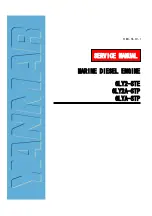
Maintenance Inspections
Teledyne Continental Motors, Inc.
TM
7-3.13. Engine Gauge Inspection
CAUTION: Inaccurate aircraft engine related gauges may cause the
pilot to operate the engine outside of the engine specification limits
and can lead to accelerated engine wear. Engine gauge calibration
errors can be particularly harmful for high horsepower engines.
Gauges may require re-marking for modified (STC) engines.
Significant engine gauge inaccuracies can lead to engine damage.
Purpose
Verify proper gauge operation and ensure reliable condition feedback to the pilot.
Frequency
During 100-hour or annual inspection
Procedure
Verify the following instruments are working properly according to the aircraft
maintenance manual instructions. Repair or replace faulty components.
•
Tachometer
•
Manifold pressure gauge
•
Fuel flow gauge
•
Oil pressure gauge
•
Oil temperature gauge
•
Cylinder head temperature gauge
•
Exhaust gas temperature gauge
7-44
IOF-240 Series Engine Maintenance Manual
Change 1
31 August 2007
NOTE: Verify EGT system accuracy. The aircraft manufacturer
may require EGT reporting be operational for all categories of
flight. Consult the Aircraft Maintenance Manual for interval and
operational requirements. In many cases, EGT calibration is a100-
hour inspection requirement.
7-3.14. Engine Control Linkage Inspection
Purpose
To ensure proper operation and to prevent accelerated wear, engine control linkage rods
must be inspected for excessive play, which can cause movement loss and parts breakage.
Frequency
During 100-hour or annual inspection
Procedure
1.
Inspect the pivot points of levers and linkages for debris, old grease, and oil.
2.
Replace worn or corroded linkage and attaching hardware in accordance with
airframe manufacturer’s instructions.
3.
Clean pivot point areas thoroughly using clean Stoddard solvent per instructions in
the section “Throttle Control Linkage Rod Maintenance” in Chapter 9, Maintenance
and Adjustments. After cleaning, dry each area using compressed air.
















































